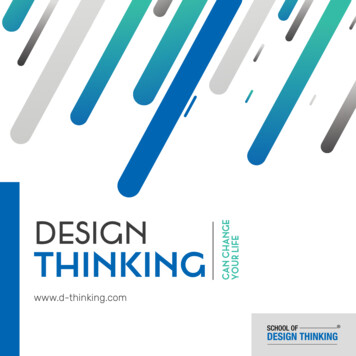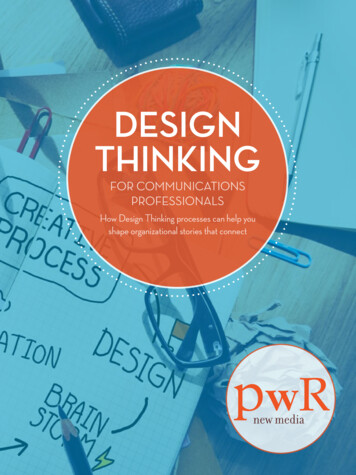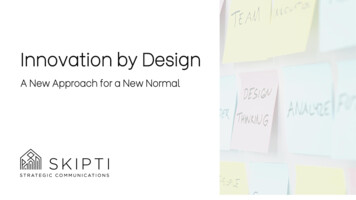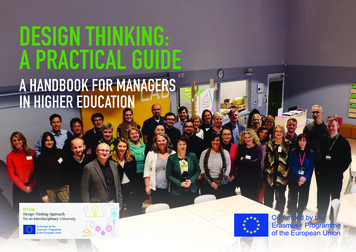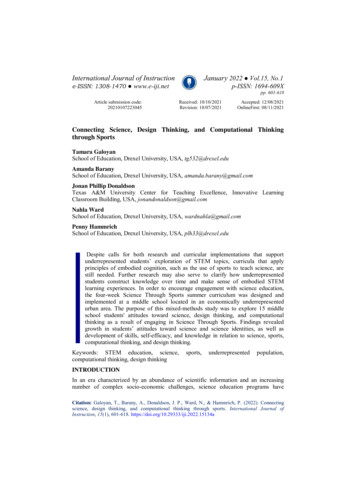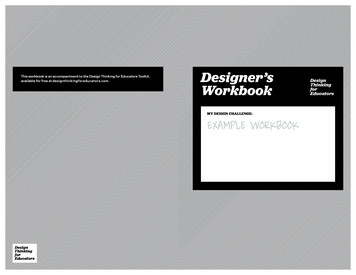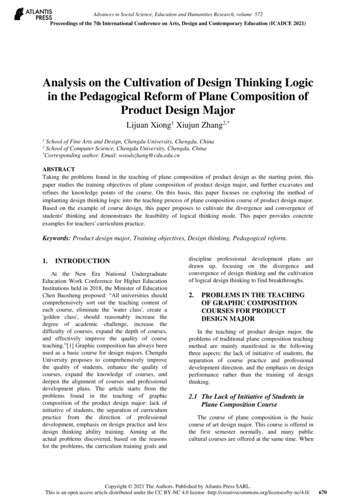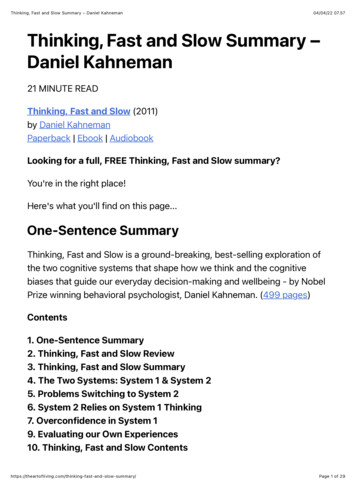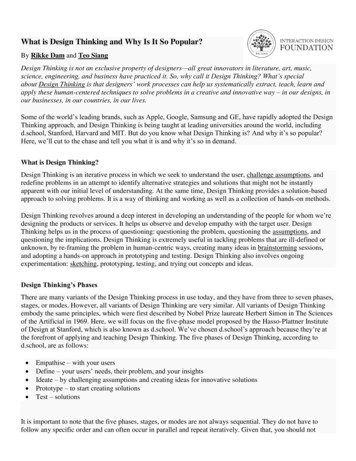
Transcription
What is Design Thinking and Why Is It So Popular?By Rikke Dam and Teo SiangDesign Thinking is not an exclusive property of designers—all great innovators in literature, art, music,science, engineering, and business have practiced it. So, why call it Design Thinking? What’s specialabout Design Thinking is that designers’ work processes can help us systematically extract, teach, learn andapply these human-centered techniques to solve problems in a creative and innovative way – in our designs, inour businesses, in our countries, in our lives.Some of the world’s leading brands, such as Apple, Google, Samsung and GE, have rapidly adopted the DesignThinking approach, and Design Thinking is being taught at leading universities around the world, includingd.school, Stanford, Harvard and MIT. But do you know what Design Thinking is? And why it’s so popular?Here, we’ll cut to the chase and tell you what it is and why it’s so in demand.What is Design Thinking?Design Thinking is an iterative process in which we seek to understand the user, challenge assumptions, andredefine problems in an attempt to identify alternative strategies and solutions that might not be instantlyapparent with our initial level of understanding. At the same time, Design Thinking provides a solution-basedapproach to solving problems. It is a way of thinking and working as well as a collection of hands-on methods.Design Thinking revolves around a deep interest in developing an understanding of the people for whom we’redesigning the products or services. It helps us observe and develop empathy with the target user. DesignThinking helps us in the process of questioning: questioning the problem, questioning the assumptions, andquestioning the implications. Design Thinking is extremely useful in tackling problems that are ill-defined orunknown, by re-framing the problem in human-centric ways, creating many ideas in brainstorming sessions,and adopting a hands-on approach in prototyping and testing. Design Thinking also involves ongoingexperimentation: sketching, prototyping, testing, and trying out concepts and ideas.Design Thinking’s PhasesThere are many variants of the Design Thinking process in use today, and they have from three to seven phases,stages, or modes. However, all variants of Design Thinking are very similar. All variants of Design Thinkingembody the same principles, which were first described by Nobel Prize laureate Herbert Simon in The Sciencesof the Artificial in 1969. Here, we will focus on the five-phase model proposed by the Hasso-Plattner Instituteof Design at Stanford, which is also known as d.school. We’ve chosen d.school’s approach because they’re atthe forefront of applying and teaching Design Thinking. The five phases of Design Thinking, according tod.school, are as follows: Empathise – with your usersDefine – your users’ needs, their problem, and your insightsIdeate – by challenging assumptions and creating ideas for innovative solutionsPrototype – to start creating solutionsTest – solutionsIt is important to note that the five phases, stages, or modes are not always sequential. They do not have tofollow any specific order and can often occur in parallel and repeat iteratively. Given that, you should not
understand the phases as a hierarchal or step-by-step process. Instead, you should look at it as an overview ofthe modes or phases that contribute to an innovative project, rather than sequential steps.To help you understand Design Thinking, we have broken the process into five phases or modes, which are:1. Empathise, 2. Define, 3. Ideate, 4. Prototype, and 5. Test. What’s special about Design Thinking is thatdesigners’ work processes can help us systematically extract, teach, learn, and apply these human-centeredtechniques to solve problems in a creative and innovative way – in our designs, in our businesses, in ournations (and eventually, if things go really well, beyond), in our lives. Nevertheless, a great artist like AugusteRodin, who created this famous sculpture called “The Thinker” and originally “Le Penseur”, would most likelyhave used the very same innovative processes in his artwork. In the same way, all great innovators in literature,art, music, science, engineering and business have practiced it and still practice it.The Problem with Ingrained Patterns of ThinkingSometimes, the easiest way to understand something intangible, such as Design Thinking, is by understandingwhat it is not.Humans naturally develop patterns of thinking modeled on repetitive activities and commonly accessedknowledge. These assist us in quickly applying the same actions and knowledge in similar or familiar situations,but they also have the potential to prevent us from quickly and easily accessing or developing new ways ofseeing, understanding and solving problems. These patterns of thinking are often referred to as schemas, whichare organized sets of information and relationships between things, actions and thoughts that are stimulated andinitiated in the human mind when we encounter some environmental stimuli. A single schema can contain a vastamount of information. For example, we have a schema for dogs which encompasses the presence of four legs,fur, sharp teeth, a tail, paws, and a number of other perceptible characteristics. When the environmental stimulimatch this schema — even when there is a tenuous link or only a few of the characteristics are present — thesame pattern of thought is brought into the mind. As these schemas are stimulated automatically, this canobstruct a more fitting impression of the situation or prevent us from seeing a problem in a way that will enablea new problem-solving strategy. Innovative problem solving is also known as “thinking outside of the box”.An Example of Problem solving: The Encumbered Vs. The Fresh MindThinking outside of the box can provide an innovative solution to a sticky problem. However, thinking outsideof the box can be a real challenge as we naturally develop patterns of thinking that are modeled on the repetitiveactivities and commonly accessed knowledge we surround ourselves with.Some years ago, an incident occurred where a truck driver tried to pass under a low bridge. But he failed, andthe truck was lodged firmly under the bridge. The driver was unable to continue driving through or reverse out.The story goes that as the truck became stuck, it caused massive traffic problems, which resulted in emergencypersonnel, engineers, firefighters and truck drivers gathering to devise and negotiate various solutions fordislodging the trapped vehicle.Emergency workers were debating whether to dismantle parts of the truck or chip away at parts of the bridge.Each spoke of a solution which fitted within his or her respective level of expertise.A boy walking by and witnessing the intense debate looked at the truck, at the bridge, then looked at the roadand said nonchalantly, "Why not just let the air out of the tires?" to the absolute amazement of all the specialistsand experts trying to unpick the problem.
When the solution was tested, the truck was able to drive free with ease, having suffered only the damagecaused by its initial attempt to pass underneath the bridge. The story symbolizes the struggles we face whereoftentimes the most obvious solutions are the ones hardest to come by because of the self-imposed constraintswe work within.It’s often difficult for us humans to challenge our assumptions and everyday knowledge, because we rely onbuilding patterns of thinking in order to not have to learn everything from scratch every time. We rely on doingeveryday processes more or less unconsciously — for example, when we get up in the morning, eat, walk, andread — but also when we assess challenges at work and in our private lives. In particular, experts andspecialists rely on their solid thought patterns, and it can be very challenging and difficult for experts to startquestioning their knowledge.The Power of StorytellingWhy did we tell you this story? Telling stories can help us inspire opportunities, ideas and solutions. Stories areframed around real people and their lives. Stories are important because they are accounts of specific events, notgeneral statements. They provide us with concrete details that help us imagine solutions to particular problems.While we’re at it, please watch this 1-minute video to help you get started understanding what Design Thinkingis about.Design Thinking is often referred to as ‘outside the box’ thinking. This child shows us why it’s important tochallenge our assumptions and find new ways to solve our problems.Design Thinking or 'Outside the Box' ThinkingDesign Thinking is often referred to as ‘outside the box’ thinking, as designers are attempting to develop newways of thinking that do not abide by the dominant or more common problem-solving methods.At the heart of Design Thinking is the intention to improve products by analyzing and understanding how usersinteract with products and investigating the conditions in which they operate. At the heart of Design Thinkinglies also the interest and ability to ask significant questions and challenging assumptions. One element ofoutside the box thinking is to falsify previous assumptions – i.e., to make it possible to prove whether they arevalid or not. Once we have questioned and investigated the conditions of a problem, the solution-generationprocess will help us produce ideas that reflect the genuine constraints and facets of that particular problem.Design Thinking offers us a means of digging that bit deeper; it helps us to do the right kind of research and toprototype and test our products and services so as to uncover new ways of improving the product, service ordesign.Grand Old Man of User Experience, Don Norman, who also coined the very term User Experience, explainswhat Design Thinking is and what’s so special about it:“ the more I pondered the nature of design and reflected on my recent encounters with engineers, businesspeople and others who blindly solved the problems they thought they were facing without question or furtherstudy, I realized that these people could benefit from a good dose of design thinking. Designers have developeda number of techniques to avoid being captured by too facile a solution. They take the original problem as asuggestion, not as a final statement, then think broadly about what the real issues underlying this problemstatement might really be (for example by using the "Five Whys" approach to get at root causes). Mostimportant of all, is that the process is iterative and expansive. Designers resist the temptation to jumpimmediately to a solution to the stated problem. Instead, they first spend time determining what the basic,fundamental (root) issue is that needs to be addressed. They don't try to search for a solution until they havedetermined the real problem, and even then, instead of solving that problem, they stop to consider a wide range
of potential solutions. Only then will they finally converge upon their proposal. This process is called "DesignThinking."– Don Norman, Rethinking Design ThinkingDesign Thinking is an Essential Tool – and A Third WayThe design process often involves a number of different groups of people in different departments; for thisreason, developing, categorizing, and organizing ideas and problem solutions can be difficult. One way ofkeeping a design project on track and organizing the core ideas is using a Design Thinking approach.Tim Brown, CEO of the celebrated innovation and design firm IDEO, shows in his successful book Change byDesign that Design Thinking is firmly based on generating a holistic and empathic understanding of theproblems that people face, and that it involves ambiguous or inherently subjective concepts such as emotions,needs, motivations, and drivers of behaviors. This contrasts with a solely scientific approach, where there’smore of a distance in the process of understanding and testing the user’s needs and emotions — e.g.,via quantitative research. Tim Brown sums up that Design Thinking is a third way: Design Thinking isessentially a problem-solving approach, crystalized in the field of design, which combines a holistic usercentered perspective with rational and analytical research with the goal of creating innovative solutions.“Design thinking taps into capacities we all have but that are overlooked by more conventional problemsolving practices. It is not only human-centered; it is deeply human in and of itself. Design thinking relies onour ability to be intuitive, to recognize patterns, to construct ideas that have emotional meaning as well asfunctionality, to express ourselves in media other than words or symbols. Nobody wants to run a business basedon feeling, intuition, and inspiration, but an overreliance on the rational and the analytical can be just asdangerous. The integrated approach at the core of the design process suggests a ‘third way.’ “– Tim Brown, Change by Design, IntroductionScience and Rationality in Design ThinkingSome of the scientific activities will include analyzing how users interact with products and investigating theconditions in which they operate: researching user needs, pooling experience from previous projects,considering present and future conditions specific to the product, testing the parameters of the problem, andtesting the practical application of alternative problem solutions. Unlike a solely scientific approach, where themajority of known qualities, characteristics, etc. of the problem are tested so as to arrive at a problem solution,Design Thinking investigations include ambiguous elements of the problem to reveal previously unknownparameters and uncover alternative strategies.After arriving at a number of potential problem solutions, the selection process is underpinned by rationality.Designers are encouraged to analyze and falsify these problem solutions so that they can arrive at the bestavailable option for each problem or obstacle identified during each phase of the design process.With this in mind, it may be more correct to say that Design Thinking is not about thinking outside of the box,but on its edge, its corner, its flap, and under its bar code, as Clint Runge put it.Copyright holder: Interaction Design Foundation. Copyright terms and license: CC BY-NC-SA 3.0Clint Runge is Founder and Managing Director of Archrival, a distinguished youth marketing agency, andadjunct Professor at the University of Nebraska-Lincoln.
Generating Creative Ideas and Solutions by Holistically Understanding HumansWith a solid foundation in science and rationality, Design Thinking seeks to generate a holistic and empatheticunderstanding of the problems that people face. Design thinking tries to empathize with human beings. Thatinvolves ambiguous or inherently subjective concepts such as emotions, needs, motivations, and drivers ofbehaviors. The nature of generating ideas and solutions in Design Thinking means this approach is typicallymore sensitive to and interested in the context in which users operate and the problems and obstacles they mightface when interacting with a product. The creative element of Design Thinking is found in the methods used togenerate problem solutions and insights into the practices, actions, and thoughts of real users.Design Thinking is an Iterative and Non-linear ProcessLearn about usersThrough testingEmpathize to helpDefine the problemTests create newIdeas for the projectLearn from Prototypesto spark new ideasTest reveal insights thatRedefine the problemCopyright holder: Interaction Design Foundation. Copyright terms and license: CC BY-NC-SA 3.0Design Thinking is an iterative and non-linear process. This simply means that the design team continuouslyuse their results to review, question and improve their initial assumptions, understandings and results. Resultsfrom the final stage of the initial work process inform our understanding of the problem, help us determine theparameters of the problem, enable us to redefine the problem, and, perhaps most importantly, provide us withnew insights so we can see any alternative solutions that might not have been available with our previous levelof understanding.
Design Thinking is for EverybodyTim Brown also emphasizes that Design Thinking techniques and strategies of design belong at every level of abusiness. Design thinking is not only for designers but also for creative employees, freelancers, and leaders whoseek to infuse design thinking into every level of an organization, product or service in order to drive newalternatives for business and society.“Design thinking begins with skills designers have learned over many decades in their quest to match humanneeds with available technical resources within the practical constraints of business. By integrating what isdesirable from a human point of view with what is technologically feasible and economically viable, designershave been able to create the products we enjoy today. Design thinking takes the next step, which is to put thesetools into the hands of people who may have never thought of themselves as designers and apply them to avastly greater range of problems.”– Tim Brown, Change by Design, IntroductionThe Take AwayDesign Thinking is essentially a problem-solving approach specific to design, which involves assessing knownaspects of a problem and identifying the more ambiguous or peripheral factors that contribute to the conditionsof a problem. This contrasts with a more scientific approach where the concrete and known aspects are tested inorder to arrive at a solution. Design Thinking is an iterative process in which knowledge is constantly beingquestioned and acquired so it can help us redefine a problem in an attempt to identify alternative strategies andsolutions that might not be instantly apparent with our initial level of understanding. Design Thinking is oftenreferred to as ‘outside the box thinking’, as designers are attempting to develop new ways of thinking that donot abide by the dominant or more common problem-solving methods – just like artists do. At the heart ofDesign Thinking is the intention to improve products by analyzing how users interact with them andinvestigating the conditions in which they operate. Design Thinking offers us a means of digging that bit deeperto uncover ways of improving user experiences.“The ‘Design Thinking’ label is not a myth. It is a description of the application of well-tried design process tonew challenges and opportunities, used by people from both design and non-design backgrounds. I welcome therecognition of the term and hope that its use continues to expand and be more universally understood, so thateventually every leader knows how to use design and design thinking for innovation and better results.”– Bill Moggridge, co-founder of IDEO, in Design Thinking: Dear Don
Design Thinking also involves ongoing experimentation: sketching, prototyping, testing, and trying out concepts and ideas. Design Thinking's Phases There are many variants of the Design Thinking process in use today, and they have from three to seven phases, stages, or modes. However, all variants of Design Thinking are very similar.
